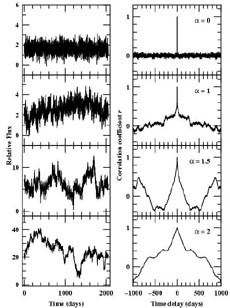


4.2. Relationship to the Transfer Function
It is useful at this point to examine how the CCF is
related to more fundamental quantities. Defined
as a function of the continuous variable
 , the
formal definition of the cross-correlation function is
, the
formal definition of the cross-correlation function is

| (32) |
If we use Eq. (21) to replace L(t) in this equation, we obtain

| (33) |
Comparing the inner integral with Eq. (32), we see that it is the cross-correlation of the continuum light curve with itself, i.e., the "autocorrelation function",

| (34) |
Thus, we see that the cross-correlation function is the convolution of the transfer function with the continuum autocorrelation function,

| (35) |
The centroid of the CCF is a usually quoted quantity,

| (36) |
which is related to the centroid of the transfer function

| (37) |
It is important to note that these two quantities are the same
only in the limit where the light curves extend to infinity.
Operationally, the centroid is computed using only points
around the most significant peak, usually those points for which
CCF( )
)
 0.8 rpeak, where
rpeak is the maximum value of the CCF. Sometimes the
location of the peak
0.8 rpeak, where
rpeak is the maximum value of the CCF. Sometimes the
location of the peak
 peak
(CCF(
peak
(CCF( peak) =
rpeak) is the statistical quantity used.
peak) =
rpeak) is the statistical quantity used.
Cross-correlation does not necessarily give a clean and unambiguous measure of the relationship between two time series. In particular, the CCF is a convolution of the transfer function with the continuum ACF, so the CCF depends on the continuum behavior. To illustrate this, we show in Fig. 26 examples of light curves for various power-law PDSs (Eq. (7)) and the very different ACFs computed for each example.

|
Figure 26. The left-hand column shows
artificial light curves generated with different power-law indices
|